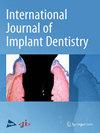High insertion torque versus regular insertion torque: early crestal bone changes on dental implants in relation to primary stability—a retrospective clinical study
IF 4
3区 医学
Q1 DENTISTRY, ORAL SURGERY & MEDICINE
引用次数: 0
Abstract
The aim of the presented retrospective study was to evaluate the early crestal bone changes around an implant type designed for high primary stability. A total number of 111 implants placed clinically were evaluated regarding insertion torque, bone density, implant stability quotient (ISQ) and early crestal bone loss from standardized digital radiographs. The implants were allocated in two groups: the „regular torque “ group contained all implants that achieved less than 50 Ncm as final insertion torque (n = 63) and the „high torque“ group contained the implants that achieved 50–80 Ncm (n = 48). To avoid possible damage either to the implant´s inner connection or to the bone by application of excessive force, a limit of 80 Ncm was set for all surgeries. All implants underwent submerged healing for three months. ISQ measurements and standardized digital radiographs were taken at day of insertion and at day of second stage surgery. The bone loss was measured on the mesial and distal aspect of the implant. The data evaluation showed the following results: Mean bone loss was 0.27 ± 0.30 mm for the high torque group and 0.24 ± 0.27 mm for the regular torque group. The difference was not statistically significant (p = 0.552). In the two groups, no complications nor implant loss occurred. For the evaluated implant type, there was no significant difference in crestal bone changes and complication rate between high and regular insertion torque in the early healing period.高插入扭矩与常规插入扭矩:牙科种植体早期骨嵴变化与主要稳定性的关系--回顾性临床研究
这项回顾性研究的目的是评估一种设计用于高度初期稳定性的种植体周围的早期骨嵴骨质变化。通过标准化的数字 X 光片,对 111 个临床植入的种植体的插入扭矩、骨密度、种植体稳定性商数(ISQ)和早期骨嵴骨质流失情况进行了评估。种植体被分为两组:"常规扭矩 "组包括最终插入扭矩小于 50 牛米的所有种植体(n = 63),"高扭矩 "组包括最终插入扭矩达到 50-80 牛米的种植体(n = 48)。为避免因用力过大而损坏种植体内部连接或骨质,所有手术的扭矩限制均为 80 Ncm。所有种植体都经过了三个月的水下愈合。在植入当天和第二阶段手术当天进行 ISQ 测量并拍摄标准化数字 X 光片。对种植体中侧和远侧的骨量损失进行了测量。数据评估结果如下高扭矩组的平均骨量损失为 0.27 ± 0.30 毫米,常规扭矩组为 0.24 ± 0.27 毫米。差异无统计学意义(P = 0.552)。两组患者均未出现并发症或种植体脱落。就所评估的种植体类型而言,在早期愈合期,高扭力组和常规扭力组的骨嵴变化和并发症发生率没有明显差异。
本文章由计算机程序翻译,如有差异,请以英文原文为准。
求助全文
约1分钟内获得全文
求助全文
来源期刊

International Journal of Implant Dentistry
DENTISTRY, ORAL SURGERY & MEDICINE-
CiteScore
1.70
自引率
7.40%
发文量
53
审稿时长
13 weeks
期刊介绍:
The International Journal of Implant Dentistry is a peer-reviewed open access journal published under the SpringerOpen brand. The journal is dedicated to promoting the exchange and discussion of all research areas relevant to implant dentistry in the form of systematic literature or invited reviews, prospective and retrospective clinical studies, clinical case reports, basic laboratory and animal research, and articles on material research and engineering.
 求助内容:
求助内容: 应助结果提醒方式:
应助结果提醒方式:


